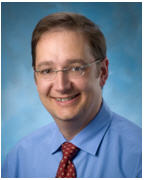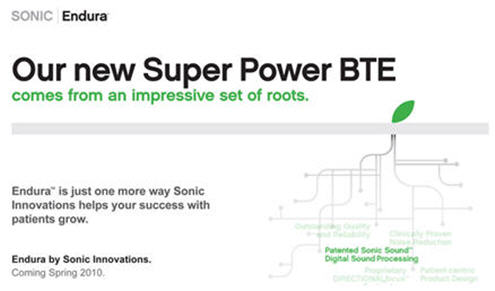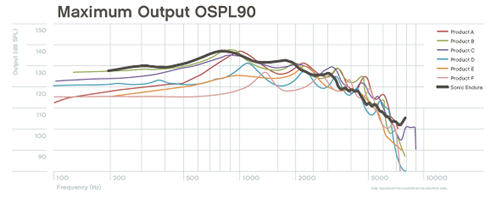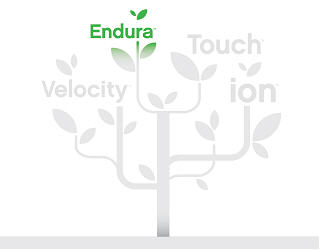Interview with Michael Nilsson, Vice President of Auditory Research, International Training, & Director, Center for Amplification and Hearing Research, Sonic Innovations
Topic: Introducing Endura™, New Super Power BTE from Sonic Innovations

Michael Nilsson
CAROLYN SMAKA: This is Carolyn Smaka from AudiologyOnline and today I have the pleasure of speaking with Dr. Michael Nilsson from Sonic Innovations. Hello, Michael.
MICHAEL NILSSON: Hello, Carolyn, so good to speak to you.

SMAKA: Tell me about what you do at Sonic Innovations, Michael.
NILSSON: I am the Vice President of Auditory Research, the Director of the Center for Amplification and Hearing Research, and I am in charge of international training.
SMAKA: What goes on at the Center for Amplification and Hearing Research?
NILSSON: Our main focus is validation testing. We evaluate everything that comes out of engineering, whether it's an idea, a change in a product, or a new product. We also do benchmark testing, and we fit devices on volunteers to make sure that products are performing up to our expectations.
SMAKA: That sounds like a fascinating job.
NILSSON: I really enjoy it. We interact with just about everybody in the company. So, we get to keep up with what everyone is doing from engineering, to sales and marketing, to training. It's a great synergy. People get excited about sharing expertise and getting everyone's input in the decision-making process, instead of just doing what one person may think is best. Ultimately, product development ends up in a much better place from this teamwork and interaction.
SMAKA: Tell me about your latest product development.
NILSSON: That would be Endura™, a Super Power BTE using a 675 battery that is being introduced at AudiologyNOW. It was designed as a result of customer and user feedback and input. It has a full feature set that incorporates all we have learned from our existing products such as Velocity™ and Touch™. The features include adaptive directionality, telecoil, auto telephone, a volume control, and up to four different programs. Our laboratory testing has shown that it is doing very well with moisture resistance, too, which improves product longevity. Endura also has a brand new housing that has received very positive comments from users. They remark that Endura feels very comfortable and light compared to the heavier power hearing aids they had previously been wearing.
Endura is our first device aimed at fitting severe to profound hearing losses, which is a population with very different needs and expectations from previous hearing devices we have developed. In the development process we asked ourselves, "What does this population look for in a hearing aid? What features are important to them?" and we implemented what we learned into Endura. In addition, using our proven Sonic Sound™ signal processing, Endura controls for background noise via directionality and noise reduction. The result is that wearers report Endura sounds very clear and they're getting more speech information.

Endura's development is rooted strongly in the strengths of Sonic Innovations' proven signal processing.
SMAKA: Do you find current super power BTE users are those that have already moved into digital devices with directionality and some adaptive features, or are they still using linear analog devices?
NILSSON: I think we're still in the transition process. Current research shows that compression can be a good thing, and we are seeing that this population can benefit from forms of compression. When digital hearing aids were first introduced, power users who had been wearing linear devices said that digital instruments with compression did not sound loud enough. Manufacturers wondered if compression would be appropriate in these cases where loudness growth is very steep, and wearers are very sensitive to gain changes. That is not the case today and we know that these users can take advantage of the same type of signal processing we're using with milder hearing losses. The same is true for directionality. When you equalize for the low cut in a directional program it will raise the noise floor because you're adding gain in the low frequency region. But as long as that noise floor remains below the patient's threshold it is not a problem. Endura has both an automatic adaptive directional program, as well as fixed directionality and we're seeing users migrate to directional programs. So their tastes, when given the chance, are similar to those with mild to moderate hearing losses. Endura has given them a chance to adjust to the benefits of directionality.
SMAKA: With the severity of hearing loss in this population, it seems that they stand to benefit more from these features than users with milder losses.
NILSSON: That's right. We have been collecting performance data using the Hearing in Noise Test (HINT) for a long time, and we have lots of data where we can look at benefit across different levels of hearing loss. This data allows us to look at benefit from amplification alone or improved audibility, and then additional benefit from directionality and from noise reduction. What our data shows is, the more severe losses get more benefit just from audibility compared to milder losses. So, audibility provides a big jump in performance for power users. Once you start adding the other technologies (e.g., directionality and noise reduction) benefits are additive. You get a big jump in improvement from audibility, and then further improvement by using a directional microphone and noise reduction.
SMAKA: So you've been able to see this difference with patients fit with Endura?
NILSSON: Absolutely. Part of the reason is our core signal processing. We're trying to provide every little bit of information we can across frequencies. Endura has more usable gain across the frequency range than some other super power products. In other products, the resonances in the receivers used often have very loud outputs, but only at certain peaks and it's not a smooth or consistent response across frequencies.
We've worked very hard to smooth out the response and to make sure we have usable gain in the low frequencies as well as the mid frequencies. This gives audiologists a wide range of frequencies that they can amplify with Endura.

SMAKA: Are there any tips or differences to keep in mind when fitting Endura as compared to fitting other products?
NILSSON: The main difference is that with Endura, the MPO value is very important. You can either measure your patient's MPO and enter it into the software or we can predict an MPO based on the audiogram. Once you work with the patient and see what volume they need, you can check and make sure the predicted MPO is set appropriately. With mild and moderate losses, we didn't emphasize MPO as the limits of the receivers were low enough that you didn't typically run into problems with loud sounds getting too loud. With Endura, the receiver is different. The peak output is 140 dB, so the MPO setting is very important. Give yourself enough room for reserve gain on the volume control, and that's about where you want your MPOs to be set.
The other change that people may notice is we allow a higher compression ratio in this device. In the past we've limited compression ratios to 4:1, and with Endura they will go up to 5:1. When you are dealing with severe and profound hearing losses, the dynamic range for these people is much narrower, and a higher compression ratio will enable us to package sounds into a narrower range.
SMAKA: From everything you're telling me about the feature set, it seems that Endura is appropriate for pediatrics as well as adults. Is that correct?
NILSSON: Yes. In addition to the features we mentioned, Endura has direct audio input (DAI), both pediatric and adult ear hooks, a tamper-resistant battery door, and we have started offering fitting kits with accessories specifically for pediatric fittings. In addition, our software has both the NAL and DSL[i/o] prescriptions, both of which have adjustments for age six years and younger. Endura also have changeable stick-ons that you can put on the case and dress it up to make it a little more fun for children.
I should also mention that Endura has an integrated DAI port, so no audio boot is necessary. You just plug the euro plug from the FM receiver directly into the case. It's completely compatible with FM systems including Microlink.
SMAKA: Great to hear about the integrated DAI port. Anything that can make things simpler with pediatric fittings is a good thing.
NILSSON: Right.

Endura joins Sonic Innovations' product portfolio that includes Touch, ion, and Velocity hearing instruments.
SMAKA: Michael, we know that people with severe and profound hearing loss often have difficulty using the telephone. Tell me about Endura's telecoil.
NILSSON: Endura is rated an industry best, M4T4 rating for telephone use. That's a rating no other super power - or ultra power, for that matter - hearing aid on the market has ever received. M1T1 is the worst rating for telephone. M4T4 is the best rating. With Endura, we have achieved an M4T4 rating in this super power instrument. I recently saw a patient with a congenital loss who has worn power products almost all of her life. We coupled her Endura hearing aids to the phone via a Bluetooth neckloop, and she came back almost in tears because it was the first time she could actually understand a voice over a cell phone.
SMAKA: Wonderful! It is great to hear of a product focused on the needs of this population, who generally rely on their hearing aids more than anyone else. Is there a software upgrade accompanying the launch?
NILSSON: There will be a new version of EXPRESSfit®, version 6.2 that will be available when Endura launches.
SMAKA: I'm looking forward to checking out Endura at AudiologyNOW! Thanks for your time in talking with me about it today.
NILSSON: You're welcome. Have a fantastic day.
About Sonic Innovations
To learn more about Endura™ and other Sonic Innovations products, visit the Sonic Innovations Web Channel on AudiologyOnline or www.sonici.com.
